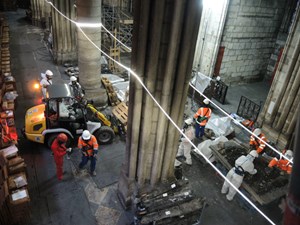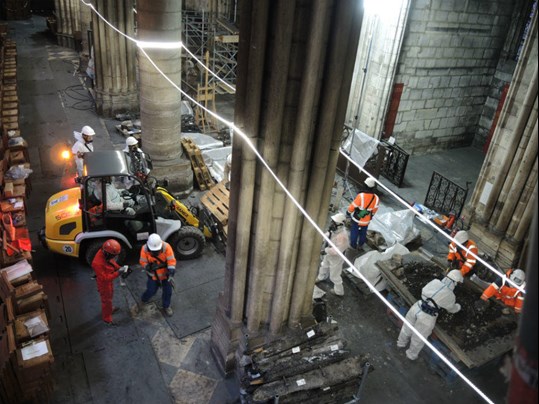
On the first anniversary of the devastating blaze that ripped through Notre-Dame Cathedral, there are no builders on site and the scientists involved are working from home. France 24 investigates how Covid-19 is affecting the reconstruction of the 850-year-old monument.
Image: Scientists analysing debris inside Notre-Dame Cathedral. © Laboratoire de recherche des monuments nationaux
The construction site engulfing Paris’s Notre-Dame Cathedral stands silent, all restoration and rubble-clearing stopped in its tracks on the first anniversary of the blaze.
Before France’s Covid-19 lockdown, around 100 workers were present at the site: engineers, architects, archaeologists and scientists. But since March 16 only a security team guards the entrance while a weekly visit by the public body overseeing the restoration ensures that everything is in order.
At 8pm on Wednesday evening the cathedral's great bell rang out
across the capital in support of the care workers on the Covid-19 frontline, and to pay tribute to the Gothic landmark's resilience.
The day before the anniversary of the fire, Jean-Louis Georgelin, the French general and former military chief of staff appointed by President Emmanuel Macron to oversee the restoration, toured the restricted zone.

Scientists analysing debris inside Notre-Dame Cathedral. © Laboratoire de recherche des monuments nationaux
“We will restart work as soon as we can,” he told FRANCE 24, adding that Covid-19 protection measures would have to be assessed “extremely carefully” to protect the employees and experts from across France who are working on the reconstruction. “We have to be sure they are protected and not exposed to this damned virus in a way that could threaten their health at either their accommodations [in Paris] or on site.”
The first employees to get back to work would be those tasked with dismantling the nearly 300 tonnes of burned and broken scaffolding on the Cathedral, said Georgelin. Originally in place to repair the roof, the fire turned the scaffolding into 40,000 pieces of mangled metal that threaten to destabilise Notre-Dame’s structure if they fall on any of the weakened walls. Only after they are painstakingly removed will the Cathedral be out of danger, although Georgelin said he is optimistic.
“We now have a year’s worth of experience to draw on. We have taken measurements all around the Cathedral and we can see that it has not moved any more than you’d expect for a gothic structure of this size,” he said, adding that he expects the scaffolding to be taken down by mid-summer.
Asked about the ambitious five-year timeline set by French President Emmanuel Macron to reopen Notre-Dame by 2024 (the year France is due to host the summer Olympics), Georgelin said simply: “We will have to roll up our sleeves and get to work.”
Meanwhile, many of the other specialists who were working on Notre-Dame will continue working from home. Experts from the Historical Monuments Research Laboratory (Laboratoire de recherche des monuments historiques) were accessing the site until mid-March, extracting and analysing the Cathedral’s stone, timber, glass and metal to assess the extent of the fire and water damage.
Thierry Zimmer, deputy director of the research laboratory, told FRANCE 24 that the work on site has come to a standstill. “Everyone went home with their hard drives,” he said, adding that now they are “writing reports and analysing data” for use when the coronavirus lockdown is lifted.
Zimmer voices a certain frustration at the delay. “We were still in the process of sorting and clearing,” he said. “We were able to take two initial samples from the vaults of Notre Dame for testing, but then we had to stop for the lockdown because it is now impossible to get up into the vaults.”
As soon as they get back on site, scientists will also be conducting tests on two chapels to assess the damage to the paintwork. That will help determine the best restoration techniques to use when the actual repair work – as opposed to securing the site, clearing debris and initial testing – finally gets under way. That is now expected to start at the beginning of next year.

ArtDependence Magazine is an international magazine covering all spheres of contemporary art, as well as modern and classical art.
ArtDependence features the latest art news, highlighting interviews with today’s most influential artists, galleries, curators, collectors, fair directors and individuals at the axis of the arts.
The magazine also covers series of articles and reviews on critical art events, new publications and other foremost happenings in the art world.
If you would like to submit events or editorial content to ArtDependence Magazine, please feel free to reach the magazine via the contact page.